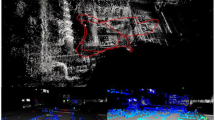Abstract
Visual odometry (VO) has been widely used for many purposes in the past decade. However, the three assumptions of VO are not often met in the reality, and therefore, the uncertainty of VO output (the pose of agent) should be estimated for safety’s sake, which can be done suitably by the integrity monitoring. To construct the integrity monitoring framework of VO, the first step is to establish the model of errors of measurements and calculate the fault rate, which has not been found in the literature to our knowledge. In response, this paper aims at establishing the model of errors of spatial points and calculating the fault rate in the stereo VO based on the feature point method. In this work, we describe the principle of stereo VO based on the feature point method in a deep and comprehensive way. The errors and faults of spatial points in stereo VO are defined, distinguished and classified in detail. The error propagation from pixel to spatial point is deduced, and the model of errors of spatial points is constructed. The KITTI odometry dataset is employed to evaluate the fault rate and standard deviation of errors of spatial points. And multiple sets of sensitive analyses are carried out to address the impact of RANdom SAmple Consensus (RANSAC) threshold, RANSAC iterations and operational scenario on spatial point error and fault rate. This paper could be a reference for constructing the integrity monitoring framework of stereo VO based on the feature point method.








Similar content being viewed by others
References
Aqel MOA, Marhaban MH, Saripan MI et al (2016) Review of visual odometry: types, approaches, challenges, and applications. SpringerPlus 5(1):1897
Bay H, Tuytelaars T, Van Gool L (2006) SURF: speeded up robust features. In: European conference on computer vision, pp 404–417
Engel J, Koltun V, Cremers D (2017) Direct sparse odometry. IEEE Trans Pattern Anal Mach Intell 40(3):611–625
Fischler MA, Bolles RC (1981) Random sample consensus: a paradigm for model fitting with applications to image analysis and automated cartography. Commun ACM 24(6):381–395
Gao X, Zhang T, Liu Y et al (2019) 14 lectures on visual SLAM: from theory to practice, 2nd edn. Publishing House of Electronics Industry, Beijing
Geiger A, Lenz P, Urtasun R (2012) Are we ready for autonomous driving? The KITTI vision benchmark suit. In: IEEE conference on computer vision and pattern recognition, pp 3354–3361
Hirschmuller H (2005) Accurate and efficient stereo processing by semi-global matching and mutual information. IEEE Comput Soc Conf Comput Vis Pattern Recognit 2:807–814
Klein G, Murray D (2007) Parallel tracking and mapping for small AR workspaces. In: 2007 IEEE and ACM international symposium on mixed and augmented reality, pp 225–234
Li CY, Waslander SL (2019) Visual measurement integrity monitoring for UAV localization. In: IEEE international symposium on safety, security, and rescue robotics (SSRR), pp 22–29
Lowe DG (2004) Distinctive image features from scale-invariant keypoints. Int J Comput Vis 60(2):91–110
Mur-Artal R, Tardós JD (2017) Orb-slam2: an open-source slam system for monocular, stereo, and rgb-d cameras. IEEE Trans Rob 33(5):1255–1262
Nister D, Naroditsky O, Bergen JR (2004) Visual odometry. In: IEEE computer society conference on computer vision and pattern recognition, vol 1, p I
Pan WC, Zhan XQ, Zhang X (2019) Fault exclusion method for ARAIM based on tight GNSS/INS integration to achieve CAT-I approach. IET Radar Sonar Navig 13(11):1909–1917
Pomerleau F, Colas F, Siegwart R (2015) A review of point cloud registration algorithms for mobile robotics. Found Trends Robot 4(1):1–104
Rublee E, Rabaud V, Konolige K et al (2012) ORB: an efficient alternative to SIFT or SURF. In: 2011 international conference on computer vision, pp 2564–2571
Scaramuzza D, Fraundorfer F (2011) Visual odometry [tutorial]. IEEE Robot Autom Mag 18(4):80–92
Scharstein D, Szeliski R (2001) A taxonomy and evaluation of dense two-frame stereo correspondence algorithms. Int J Comput Vis 47(1–3):7–42
Wang SZ, Zhan XQ, Fu YW et al (2020) Feature-based visual navigation integrity monitoring for urban autonomous platforms. In: Aerospace systems, pp 1–13
Zhai YW, Joerger M, Pervan B (2018) Fault exclusion in multi-constellation global navigation satellite systems. J Navig 71(6):1281–1298
Zhan H, Weerasekera CS, Bian J, et al (2019) Visual odometry revisited: what should be learnt? [J]. arXiv preprint arXiv:1909.09803
Zhu C, Joerger M, Meurer M (2020) Quantifying feature association error in camera-based positioning. In: IEEE/ION position, location and navigation symposium (PLANS), pp 967–972
Acknowledgements
This work is supported by China Postdoctoral Science Foundation (Grant no. 2019M661511) and Innovation Fund from Engineering Research Center of Aerospace Science and Technology, Ministry of Education.
Author information
Authors and Affiliations
Corresponding author
Rights and permissions
About this article
Cite this article
Fu, Y., Wang, S., Zhai, Y. et al. Visual odometry errors and fault distinction for integrity monitoring. AS 3, 265–274 (2020). https://doi.org/10.1007/s42401-020-00062-x
Received:
Revised:
Accepted:
Published:
Issue Date:
DOI: https://doi.org/10.1007/s42401-020-00062-x




